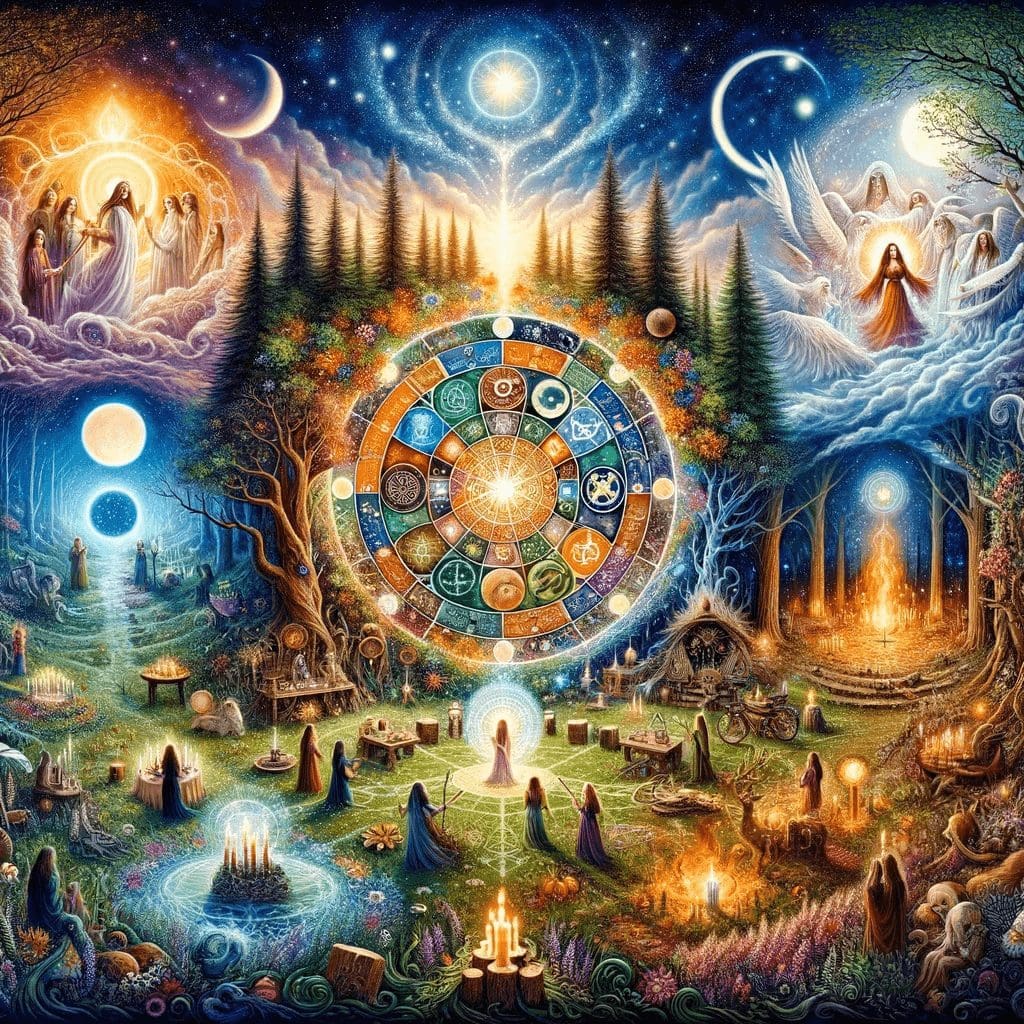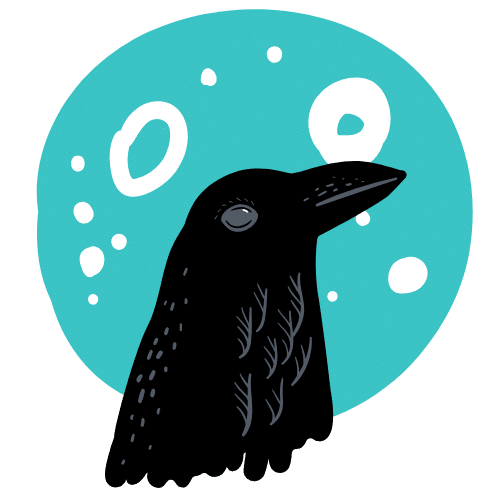LEARN | PAGAN HOLIDAYS
PAGAN HOLIDAYS: OVERVIEW, ORIGIN, SABBATS, & MORE
A Yearly Spiritual Bonanza
Updated: April 14, 2024

2024 Pagan Holidays/Sabbat Dates
- Imbolc: February 1, 2024 – Feb 2nd, 2024
- Lupercalia: February 13, 2024 – Feb 15th, 2024
- All Snakes Day: March 17, 2024
- Ostara (Spring Equinox): March 19, 2024
- Beltane: May 1, 2024
- Litha (Midsummer / Summer Solstice): June 20, 2024
- Lughnasadh / Lammas: August 1, 2024
- Mabon (Autumn Equinox): September 22, 2024
- Samhain: October 31, 2024
- Yule (Winter Solstice): December 21, 2024
Overview
Pagan holidays, known as Sabbats, form the Wheel of the Year – a cycle of celebrations that honor the seasons, lunar phases, and agricultural rhythms of the Earth. From the fertile bloom of Beltane to the quiet introspection of Yule, these holidays provide a path for pagans to connect deeply with nature’s wisdom and the divine. These festivities, steeped in ancient tradition and modern interpretation, unite a kaleidoscope of pagan paths in a shared reverence for the Earth and its cyclical dance of life, death, and rebirth.
The Different Pagan Holidays: Greater and Lesser Sabbats
The merry-go-round of the pagan Wheel of the Year spins around two types of stops: the Greater Sabbats and the Lesser Sabbats. But what’s the difference between these two? Well, let’s take a ride on this spiritual carousel and find out.
Greater Sabbats: 4 Cross-Quarter (fire) Festivals
The Greater Sabbats mark the midpoints between the solstices and equinoxes and are deeply rooted in the earth’s natural cycles and ancient agricultural practices. The Greater Sabbats include Samhain, Imbolc, Beltane, and Lammas. These are key moments for engaging with nature, celebrating transitions, and embracing community through rituals and feasting. Greater Sabbats are more closely tied to older, often pre-Christian agricultural festivals.
Lesser Sabbats: 4 Quarter-Point (solar) Festivals
The Lesser Sabbats align with the solstices and equinoxes and are primarily solar celebrations that focus on the sun’s position and its influence on the earth. Lesser Sabbats, while equally significant, are aligned with the astronomical calendar (solstices and equinoxes) and are more universally observed across various cultures and even modern secular societies. Yule, Ostara, Litha, and Mabon—are more universally celebrated across different cultures due to their clear astronomical significance.
Ostara (Spring Equinox)
March
Litha (Summer Solstice)
June
Mabon (Autumn Equinox)
September
Yule (Winter Solstice)
December
The Wheel of the Year
The Wheel of the Year is like the calendar of paganism. Instead of revolving around national holidays and clearance sales, it’s anchored in the ebb and flow of seasons, celestial events, and the cyclical dance of life, death, and rebirth.
Origins of Pagan Holidays
Pagan holidays draw from a rich history of traditions across the globe, rooted in the spiritual practices of various indigenous and polytheistic cultures. From the veneration of deities to the celebration of natural cycles, these traditions are like spiritual fossils, bearing the imprints of human interaction with nature and the divine since ancient times. Whether emerging from the fertile soil of pre-Christian Europe, the vast landscapes of Africa, the ancient civilizations of the Americas, or the diverse cultures of Asia and Oceania, each contributes to the colorful mosaic of pagan celebration. Paganism refers to a variety of spiritual or religious practices outside of the major monotheistic traditions, often encompassing indigenous, polytheistic, and nature-based beliefs.
Modern Holidays with Pagan Roots
Many modern holidays carry a pinch of pagan flavor. Christmas, with its yule log and tree decorations, echoes the pagan Yule. Easter’s bunnies and eggs mirror symbols of fertility associated with Ostara. Even Halloween, with its costumes and jack-o-lanterns, bears the ghostly imprint of Samhain. It’s as if modern holidays are masquerading at a pagan costume party, bearing traces of their ancient attire beneath their contemporary masks.
Pagan Origins of Easter, Christmas, Valentine’s Day, Halloween, and Birthdays
Whether it’s Easter eggs or Halloween haunts, our modern holidays have been quietly keeping their pagan origins alive, like a spiritual DNA passed down through the centuries. And isn’t that something to celebrate?
Valentine's Day
This day of love has its roots in the Roman festival of Lupercalia, a wild celebration of fertility. The romantic love notes passed between lovers might just be the spiritual descendants of ancient love charms. It seems Valentine’s Day has been taking flirting lessons from Lupercalia.
Easter & Ostara
Easter dives into rebirth with roots in Christian and Jewish traditions, marked by eggs and bunnies under the first full moon after the equinox. On the flip side, Ostara celebrates spring’s renewal without ancient ties. Named for the season’s essence rather than deep history, it’s a modern nod to new beginnings. Both honor spring’s fresh start, each from its unique tradition, spotlighting the season’s revival.
Halloween and Samhain
This spook-tacular holiday bears the ghostly imprint of Samhain, the pagan New Year. The costumes, jack-o-lanterns, and the focus on the spirit world are all eerily reminiscent of this ancient festival. Halloween appears to have tiptoed through Samhain’s graveyard and borrowed a few bones.
Yule and Christmas
Deck the halls with boughs of holly? That’s something Christmas seems to have picked up from the pagan Yule, the winter solstice celebration. The evergreens symbolize enduring life in the heart of winter, and the yule log is a warm nod to the returning sun. It’s as if Christmas took a leaf (or a few) out of Yule’s book.
Birthdays
The celebration of birthdays was considered a pagan tradition in early Christian times, thanks to the custom of honoring the birth of deities and the casting of horoscopes on one’s birth date. The tradition of birthday candles? It traces back to the Greek tradition of placing candles on a cake to honor the lunar goddess Artemis, making a glowing tribute to the moon. Birthdays, it seems, have been taking a midnight stroll with Artemis.
Benefits of Celebrating Pagan Holidays
Celebrating pagan holidays is like tuning your spiritual radio to the frequency of nature’s rhythms. It cultivates a sense of connection to the earth and the cosmos, deepens your understanding of life’s cycles, and can bring a sense of magic and enchantment into your daily life. Plus, who wouldn’t love an excuse for an extra celebration?
Challenges of Celebrating Pagan Holidays
On the flip side, celebrating pagan holidays can come with its own set of challenges. There’s the potential for misunderstanding or prejudice from those unfamiliar with paganism. The rituals might feel foreign at first, like trying to salsa when you’ve only ever waltzed. And aligning celebrations with natural and lunar cycles can be tricky in our modern, often hectic, schedules. It’s like trying to host a dinner party when the guests might arrive at any time.
But like any meaningful journey, the path of paganism, with its vibrant array of holidays, is one rich with learning, discovery, and spiritual growth. And with every turn of the Wheel of the Year, there’s a chance to deepen your connection to the rhythms of nature, the dance of the cosmos, and the song of your own spirit. Now, isn’t that something to celebrate?

Embrace the Moon's Rhythm
Delve deeper into lunar lore with us. Tracking full moons, new moons, and more!
Journey Through Paganism
From sacred holidays to sigil crafting, nature magic, celestial divination, and spiritual energy harnessing.
Sabbats
You’ve just stumbled upon your new favorite travel guide through the cosmic Pagan holiday calendar that is the Wheel of the Year.
Imbolc
February
Ostara
March – Spring Equinox
Beltane
May
Litha
June – Summer Solstice
Lughnasadh
August
Mabon
September – Autumn Equinox
Samhain
October
Yule
December – Winter Solstice
